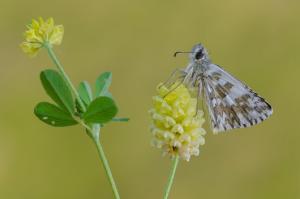Range shift and butterflies
One of the greatest future threats against biodiversity is climate change. Climate change will induce both rapid environmental changes, such as floods and droughts, and slow changes such as temperature increase, sea level rise and range shifts of biomes (Sala, et al., 2000; Omann, et al., 2009). How climate change will affect biodiversity is a complex question, and a deep understanding of how species counter new climatic conditions are needed in order to mitigate the threats of a changing climate. One predicted consequence is that biomes will move against the poles, which has already been observed to affect ecosystems of the world (Parmesan & Yohe, 2003). The range shift velocity is expected to vary between 0 to almost 8 km yr-1 depending on biome, geographic location and topography (Loarie, et al., 2009), where flat areas are predicted to experience the highest velocity (Scholes, et al., 2014). A species chance of survival will depend on their ability to either keep pace with the range shift or adapt to an unsuitable habitat (Buckley, et al., 2012; Bennett, et al., 2015). One common method to assess future geographical distributions of species is to compare the current climatic condition of the species range with projected distribution of climatic conditions (Pacifici, et al., 2015; Settele, et al., 2008). However, these models exclude factors that could interfere with the species success to follow and colonize new areas, for example dispersal ability and its adaptability to unfavourable conditions. Suitable habitat will decrease as temperature increase and it will be vital for the species to colonize new area in order to survive. Hence, it is crucial to understand the mechanisms behind a species success or failure to follow its range shift in order to prevent future extinctions.
A major concern for biodiversity conservation is therefore whether species will be able to reach and establish new populations in newly suitable habitat at their northern range limit (Pacifici, et al., 2015). The traits needed for a successful range shift is often assumed rather than quantified, even though a few studies have observed traits to affect species vulnerability of climate change. Traits proposed to be important is dispersal abilities (Pöyry, et al., 2009; Santini, et al., 2016; Garcia, et al., 2014), number of generations (Melero, et al., 2016) as well as specialized habitat and food preferences (Pöyry, et al., 2009; Melero, et al., 2016; Dapparto & Dennis, 2013; Pateman, et al., 2012). The importance of different traits varies between studies, but dispersal ability and ecological generalisation is commonly identified as highly significant (Estrada, et al., 2016). Habitat availability is a necessity for a species in order to move with its range shift (Mair, et al., 2012; Oliver, et al., 2015; Tainio, et al., 2016), with the consequence that specialized species are likely to be more vulnerable than generalist species in industrialized and fragmented landscapes. Dispersal ability is generally considered to have a key role in a species ecology since it affects a range of important mechanisms, such as population dynamics, genetic exchange, adaption and geographical distribution. However, it is likely that other colonization related traits also have a significant role (Estrada, et al., 2016). Traits have been suggested as a simple way to estimate species range shift ability. Further investigation of the relative importance of each trait is needed in order to use this tool to assess species vulnerability to climate change.
Butterflies and moths could be used as indicator organisms to detect ongoing range shifts since they have well studied distributions, short generations and are sensitive to environmental conditions. The ability for butterflies to keep track of their climate range seems to vary (Pearson, 2006; Urban, 2015), but it has been shown that many species has expanded their distribution range towards the poles during the last decades (Mair, et al., 2012; Mason, et al., 2015; Sgardeli, et al., 2016; Parmesan, et al., 1999; Hickling, et al., 2006; Pöyry, et al., 2009). This ongoing migration and extinction could be expected to increase with climate change, and as a result affect the butterfly community worldwide (Martay, et al., 2016; Sgardeli, et al., 2016; Pardikes, et al., 2015; Kwon, et al., 2014; Konvicka, et al., 2003). Sweden has for example found 37 new butterfly and moth species in Scania during the last four decades, an immigration that probably is influenced by temperature increase (Pettersson & Franzén, 2009). The success of a butterfly’s northern expansion should depend on the species traits and habitat requirements, where butterflies connected to nature types will be more vulnerable than others. Many butterflies dependent on well managed meadows with high plant diversity could be expected to have limited success in range shifts in Europe, since this habitat is highly fragmented and are predicted to continuously decrease due to land-use and climate change (Lehsten, et al., 2015; Thuiller, et al., 2005).
Aim of this study

This study investigated the Pyrgus armoricanus (Oberthür, 1910) chance for a northern range expansion and which traits connected to colonization that has the greatest influence. P. armoricanus is a specialist butterfly with its northern range margin in the southeast part of Sweden, but occurs throughout south Europe. The butterfly’s specialization in dry and well grazed meadows makes them vulnerable in today’s highly industrialized landscape and a range shift could be troublesome due to the lack of suitable habitat. A model was built to imitate Pyrgus armoricanus population dynamics, habitat distribution and traits in order to investigate the species chance of expansion in Sweden in a warmer climate. The model also explored the influence of habitat specialization, growth, probability of emigration, probability of establishment and dispersal ability on the butterfly’s range shift success.
Responsible for this page:
Director of undergraduate studies Biology
Last updated:
04/27/17
